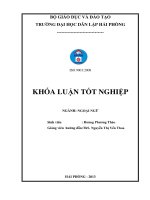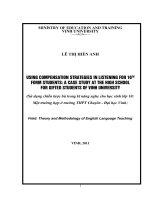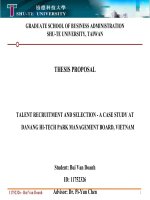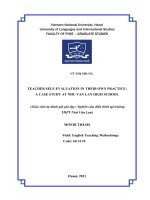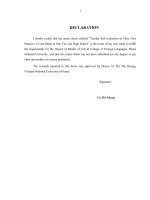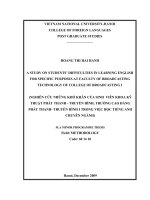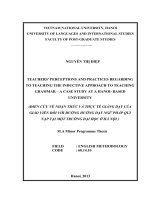Undergraduate students’ attitude towards learning english a case study at nong lam university
Bạn đang xem bản rút gọn của tài liệu. Xem và tải ngay bản đầy đủ của tài liệu tại đây (206.05 KB, 7 trang )
VNU Journal of Science: Education Research, Vol. 33, No. 4 (2017) 1-7
Undergraduate Students’ Attitude Towards Learning English:
A case Study at Nong Lam University
Vo Van Viet*
Nong Lam University,………… Vietnam
Received 30 November 2017
Revised 15 December 2016; Accepted 25 December 2017
Abstract: Effective learning a second language is influenced by many factors. Among of those,
attitude has been identified as an important one. Better understanding of students' attitude will help
language teaching programmers, school managers and educators to develop strategies to improved
student’s learning outcomes. The drive of this study is to explore students’ attitude toward learning
English. Data were collected through a questionnaire from a total of 694 students at Nong Lam
University. The results of the study showed that the students have positive attitude toward learning
English as a foreign language.
Keywords: Attitude, student, English.
1. Introduction *
Belief is an important factor determining
achievement in language learning. If learners
believe that they cannot do well, then that belief
would be a major obstacle to successful
learning a language (Lennartsson, 2008).
Negative attitudes can hinder learning.
However, a negative attitude can be changed
and turned into a positive attitude, a positive
outcome. Attitude is considered an important
factor affecting language learning. Positive
attitude towards learning languages is a good
starting point to learn a language. Language
attitudes, according to (Crystal, 1997), are the
feelings people have about their own language
or language of others.
In Vietnam, although English has become a
compulsory subject for higher education
academic programs throughout the country, but
it can be said that the effectiveness of teaching
and learning has not met any expectations.
Researchers and educational administrators are
very much concerned about how to improve the
quality of teaching and learning. In the context
English has become a language of
international communication, a language of
business, banking and finance, science and
technology, cultural exchange and international
relations worldwide. Many studies have shown
that people are interested in a particular second
language when they see that the language is a
tool to achieving high economic status,
ensuring life and satisfying one’s life values.
Practice has shown that proficiency in English
is the key to success in life. Learner's attitude
towards learning languages is one of the crucial
factors determining the success or failure.
Attitude is considered as an important
concept to understand human behavior and is
defined as a mental state includes beliefs and
feelings (Latchanna, G. & Dagnew, A, 2009).
_______
*
Tel.: …………...
Email:
/>
1
2
V.V. Viet / VNU Journal of Science: Education Research, Vol. 33, No. 4 (2017) 1-7
of ongoing changes in the theory and
methodology of teaching, the students (not the
teachers) have the central role and attitudes of
learners hold important positions in improving
effective teaching and learning. Understanding
the motivation, attitudes of learners will help
curriculum developers design programs that
meet objectives of the students and improve the
academic achievement. From the above
situation and context, this study was conducted
to explore the attitude of students towards
learning English, a survey at Nong Lam
University Ho Chi Minh City, Viet Nam.
2. Methodology
This study used quantitative approach.
Primary data for the research was collected
through questionnaires. The questionnaire
consists of two independent sections including
demographic profile questions, attitude
questions. Attitude items were selected and
adjusted from survey instruments developed by
Samar Rukh (2014) and Sk. Abdullah al
Mamun et al. (2012). Participants were asked to
rate each statement by their level of agreement
in a close ended 5-level Likert scale with 5 =
strongly agree, 4 = agree, 3 = Normal, 2 =
disagree, 1 = strongly disagree.
NonProbability Sampling, or convenience sampling
has been adopted to select participants for the
study. A total of 694 useable questionnaires
returned and used for the analysis. Data were
analyzed using the Statistical Package for the
Social Sciences (SPSS® Version 22.0 for
Windows). Descriptive statistics was conducted
to determine the frequency, the mean, and the
standard deviation of the demographic profile
and attitudinal data.
Because the study was conducted only at
Nong Lam University based in Ho Chi Minh
City, so the research findings provide only
partial pictures about the students' attitudes
toward learning English. Furthermore, data for
the research based mainly on respondents’
opinion about the statements in the
questionnaire, so the assumption is that students
have answered honestly and forthrightly.
3. Definition of language attitude
Attitude is main concept of social
psychology. Attitudes towards language are the
feelings about one’s language and the languages
of others (Crystal 1997). Linguistic behavior
can be explained by language attitude.
According to Baker (1992) the restoration,
preservation or death in the life of the language
depends fundamentally on the attitudes of
people towards that language.
Many studies have focused on the three
components of attitude include cognitive,
emotional
and
behavioral.
Component
"cognitive" refers to any information, fact or
knowledge relevant to an attitudinal subject
includes the thoughts, beliefs and values of a
language. Component "emotional" or "feelings"
is comments (positive or negative) about the
language (Baker, 1992; Rajecki, 1982). Third
component is "behavior", a behavioral intention
or the action can be done (possible acts) for the
language (Rajecki, 1982). These three
components have a reciprocal influence
(Wenden, 1991).
d
Source: (Hilgard, 1980)
4. Result and discussion
Demographic profile
V.V. Viet / VNU Journal of Science: Education Research, Vol. 33, No. 4 (2017) 1-7
3
Table 1. Demographic profile of the sample
Items
Gender
Female
Male
Year of study
Freshman
Sophomore
Junior
Senior
Others
Time began to study
From primary school
From secondary school
From high school
From college
Taking extra English courses
No
Yes
Self- Assessment of English Skill
Very bad
Bad
Fairly Good
Very good
Excellent
Frequency
422
272
Percentage
60,8
39,2
121
259
248
63
3
17,4
37,3
35,7
9,1
,4
227
438
9
20
32,7
63,1
1,3
2,9
434
260
62,5
37,5
85
236
347
24
2
12,2
34,0
50,0
3,5
0,3
3
The total number of respondents of this
study was 694. The distribution of sample of
the study is shown in Table 1. The profile of
respondents was described as follows:
Gender: Respondents were asked to state
their gender. The analysis of the demographic
variables indicates that there are more female
than male respondents. The numbers of male
and female in the sample were accordingly 272
(39.2%) and 442 (60.8%).
Years of study: Respondents were asked to
indicate their year of study. There were 17.4%
freshman (n=17,4), 37.3% Sophomore (n=259),
35.3% Junior (n=248), 9.1% senior (n=63) and
others 0.4% (n=3).
The questionnaire also inquired about the
time began to study English of each student.
227 respondents (32.7%) have been studying
English from primary school; 438 respondents
(63.1%) from secondary school; 9 respondents
(1.3%) from high school; 20 respondents
(2.9%) from college. Two hundred sixty
respondents (37,5%) said that they are taking
extra English courses besides the college
curriculum. 434 respondents (62.5%) are not
taking any extra English courses.
Respondents were also asked to assess their
English skill. A half of respondents, fifty
percent (n=347), have classified as fairly good
at English; 321 respondents classified as bad
and very bad.
5. Exploratory Factor Analysis (EFA)
Factor analysis is used to identify latent
constructs or factors. It is commonly used to
reduce variables into a smaller set to save time
and facilitate easier interpretations. In this
study, EFA have been conducted in 22 items
(observable variables) to be reduced to three
latent variables that share a common variance
and are unobservable.
The example is suitable for EFA as the
KMO is 0.883>0,5. Noted that, the Kaiser
Criterion is said to be reliable when: a) the
averaged extracted communalities is at least
V.V. Viet / VNU Journal of Science: Education Research, Vol. 33, No. 4 (2017) 1-7
4
more than .70 and when there are less than 30
variables, or b) the averaged extracted
communalities is equal or above .60 and the
sample size is above 250 cases (Field, 2009).
The result of EFA with Principal
Components analysis is used to extract
maximum variance from the data set with each
component thus reducing a large number of
variables into smaller number of components
and
Varimax
rotation
with
Kaiser
Normalization resulted in three factors with
extracted variance is 50,02%>50%. The first
factor includes 9 items named emotional factor.
The second factor includes 9 items named
cognitive factor. The last factor includes 4 items
named behavioral factor. The result of final
EFA was presented in table 2.
Table 2. EFA
Items
You like to learn English
You like someone else speaking with you in English
You like to speak English
You like to read books, documents and journals in English
You like watching TV shows in English
In general, you realize that learning English is important and you love
learning English
You spend a lot of time learning English.
You will enroll an extra English course even if it is not a compulsory
subject in the school
Being able to communicate with foreigners in English is a fundamental
purpose of learning English.
Being able to speak English is an advantage in the present time
You need English to be more successful in your studies
English is an important tool in scientific research
All students should learn English
Learning English is important to you, because English is a very useful
tool in modern society
When someone speaks English, you think they make a good impression.
Learning English will help to develop your mind.
Students should regularly use English in communication
When someone speaks English you think they are good and qualified
The important purpose of learning English is to get high score in English
Tests
The important goal for learning English is to get a college degree
The important purpose of learning English is to have a good job
You learn English to make good academic progress
1
0,767
0,760
0,729
0,717
0,668
Factors
2
3
0,662
0,647
0,495
0,319
0,779
0,751
0,662
0,639
0,626
0,562
0,521
0,504
0,408
0,822
0,745
0,549
0,504
l
6. Attitude of student towards learning English
Student’s attitude was evaluated by the
mean of the 22 main items of the survey. In
which, each statement in the items was
evaluated on a 5-level Likert scale (from 1 to
5), where value 5 was the most positive (very
agreeable), value 1 was the most negative (Very
disagree). To draw conclusions about students'
attitudes towards the survey factors, agreed on
the distribution of the average value of the
observed variables is as follows: 1 to 1.8 (very
negative); from 1.8 to near 2.6 (negative); From
2.6 to near 3.4 (normal); from 3,4 to 4,2
(positive), from 4,2 to 5 (very positive).
V.V. Viet / VNU Journal of Science: Education Research, Vol. 33, No. 4 (2017) 1-7
5
Table 3. Descriptive analysis
Strongly
Disagree Neutral
disagree
Items
Learning English is
important to you,
because English is a
very useful tool in
modern society
When someone speaks
English you think they
are good and qualified
When someone
speaks English, you
think they make a
good impression.
Being able to speak
English is an
advantage in the
present time
English is an
important tool in
scientific research
You need English to
be more successful in
your studies
Learning English
will help to develop
your mind.
Agree
Strongly
agree
Frequency
33
1
10
223
427
(%)
4.8
0.1
1.4
32.1
61.5
Frequency
12
58
167
380
77
(%)
1.7
8.4
24.1
54.8
11.1
Frequency
15
29
113
409
128
(%)
2.2
4.2
16.3
58.9
18.4
Frequency
26
0
8
209
451
(%)
3.7
0
1.2
30.1
65.0
Frequency
15
7
55
337
280
(%)
2.2
1.0
7.9
48.6
40.3
Frequency
20
4
35
317
318
(%)
2.9
0.6
5.0
45.7
45.8
Frequency
9
25
143
371
146
(%)
1.3
3.6
20.6
53.5
21.0
You like to learn
English
Frequency
13
36
241
300
104
(%)
1.9
5.2
34.7
43.2
15.0
You like to speak
English
Frequency
6
40
183
301
164
(%)
0.9
5.8
26.4
43.4
23.6
You like someone
else speaking with
you in English
Frequency
15
126
257
227
69
(%)
2.2
18.2
37.1
32.7
9.9
7
103
313
212
59
1.1
14.8
45.1
30.5
8.5
You like watching TV Frequency
shows in English
(%)
You like to read
books, documents
and journals in
English
Frequency
10
149
333
162
40
(%)
1.4
21.5
48.0
23.3
5.8
All students should
learn English
Frequency
18
16
56
327
277
Percent (%)
2.6
2.3
8.1
47.1
39.9
Frequency
14
31
135
358
156
(%)
2.0
4.5
19.5
51.6
22.5
Students should
regularly use English
in communication
Mean
Std.
deviation
4.46
.926
3.65
.849
3.87
.833
4.53
.850
4.24
.813
4.31
.834
3.89
.817
3.64
.864
3.83
.884
3.30
.950
3.31
.861
3.11
.852
4.19
.877
3.88
.875
V.V. Viet / VNU Journal of Science: Education Research, Vol. 33, No. 4 (2017) 1-7
6
You will enroll an
extra English course
even if it is not a
compulsory subject
in the school
You learn English to
make good academic
progress
The important goal for
learning English is to
get a college degree
The important
purpose of learning
English is to have a
good job
The important purpose
of learning English is
to get high score in
English Tests
Being able to
communicate with
foreigners in English is
a fundamental purpose
of learning English.
You spend a lot of
time learning
English.
In general, you
realize that learning
English is important
and you love
learning English
Frequency
18
32
86
395
163
(%)
2.6
4.6
12.4
56.9
23.5
Frequency
12
72
168
341
101
(%)
1.7
10.4
24.2
49.1
14.6
Frequency
52
278
157
180
27
(%)
7.5
40.1
22.6
25.9
3.9
Frequency
16
24
77
407
170
(%)
2.3
3.5
11.1
58.6
24.5
Frequency
30
140
236
238
50
(%)
4.3
20.2
34.0
34.3
7.2
Frequency
10
28
87
392
177
(%)
1.4
4.0
12.5
56.5
25.5
Frequency
10
77
428
155
24
(%)
1.4
11.1
61.7
22.3
3.5
Frequency
9
9
152
357
167
(%)
1.3
1.3
21.9
51.4
24.1
3.94
.880
3.64
.913
2.79
1.035
4.00
.838
3.20
.984
4.01
.820
3.15
.713
3.96
.792
Attitude
3.7678
.43468
Cognitive
4.1428
.55572
Behavioral
3.4063
.65676
Emotional
3.5616
.57557
l
Statistical results (see Table 3) show that
the mean value of attitudes toward English
learning of 694 respondents in the survey was
3.77 (standard deviation of 0.43). This data
shows that students have a positive attitude
towards learning English. In addition, the mean
of the three components of attitudes including
cognitive, emotional and behavioral was
positive, with the cognitive component
achieving the highest value of 4.14 (the
standard deviation is 0.55, followed by the
emotional component of 3.56 (standard
deviation of 0.57) and the behavioral
component of 3.4 (standard deviation of 0.65).
Around 61.5% of respondentsagreed with
the statement that “learning English is
important because it’s a very useful tool in
modern society”. The majority of respondents
(95%) agreed with the statement that “speaking
English is an advantage in the present time”.
88.9% of the students in the sample agree and
strongly agree with the statement that English is
V.V. Viet / VNU Journal of Science: Education Research, Vol. 33, No. 4 (2017) 1-7
an important tool in scientific research. 99.5%
of the students in the sample agree and strongly
agree with the English speech to help them
succeed in their studies. 47.1% of all students
should learn English, 39.9% would agree.
74.1% agreed and very much in line with the
statement that students should regularly use
English in communication. 83.1% of
respondentsagreedand strongly agreed with
theitem “the purpose of learning English is to
have a suitable job”. 82% of respondents agreed
and strongly agreed with the statement that the
basic purpose of learning English was to be
able to communicate with foreigners.
At the same time, the figures also show that
the students in the sample appreciated English
speakers. Specifically, 54.8% agreed, 11.1%
strongly agreed that when someone speaks
English, they are good and qualified. In addition,
58.9% agreed and 18.4% strongly agreed that
speaking English would make a good impression.
However, 18.2% of the students in the sample did
not like others talking to themselves in English.
14.8% did not like watching TV shows in
English. 21.5% do not like to read more books,
documents, magazines in English. 11.1% disagree
with the statement "you spend a lot of time
learning English”.
6. Conclusion
From the results of the analysis above, we
can conclude that most students are aware of
the importance of English in their studies and in
future career development. However, there is
still a gap between awareness, attitude and their
actions. Therefore, furtherstudies should be
conducted to develop more understanding of
students’ attitudes towards learning English and
the factors that may affect their learning
achievement.
References
[1] Allport, G.W. (1935) Attitudes. In: Murchison,
C., Ed., A Handbook of Social Psychology, Clark
University Press, Worcester.
[2] Baker, C. (1992). Attitudes and language.
Clevedon Hall: Multilingual Matters.
7
[3] Bem, D.J. (1970). Beliefs, attitudes, and human
affairs. Belmont, CA: Brooks/Cole.
[4] Crystal, D. (1997). A Dictionary of Linguistics
and Phonetics (4th ed.). UK.
[5] Eagly, A. H. (1993). The psychology of attitudes.
Fort Worth, TX: Harcourt Brace Jovanovich.
[6] Fakeye, D. (2010). Students’ Personal Variables
as Correlates of Academic Achievement in
English as a Second Language in Nigeria.
Journal of Social Sciences, 22(3), 205-211.
[7] Gardner, R. (2008). Individual Differences in
Second and Foreign Language Learning. (N. D.S. Hornberger, Ed.) Encyclopedia of Language
and 213 Education, 4. [Second and Foreign
Language Education], pp. 29-40.
[8] Gömleksiza, M. N. (2010). An evaluation of
students’ attitudes toward English language
learning in terms of several variables. Procedia
Social and Behavioral Sciences, 9 (2010), 913–
918.
[9] Hilgard, E. R. (1980). The trilogy of mind:
Cognition, affection, and conation. Journal of
the History of the Behavioral Sciences, 107-117.
[10] Latchanna, G. & Dagnew, A. (2009). Attitude of
teachers towards the use of active learning
methods. E-journal of All India Association for
Educational Research, 21(1).
[11] Lennartsson, F. (2008). Students' motivation and
attitudes towards learning a second language:
British and Swedish students' points ofview.
/>u:diva-2571.
[12] Mamun, S. A. (2012). Students’ Attitudes
towards English: The Case of Life Science
School of Khulna University. International
Review of Social Sciences and Humanities, Vol.
3, No. 1 (2012), 200-209.
[13] Rajecki, D. W. (1982). Attitudes, Themes and
Advances. Sinauer Associates.
[14] Rukh, S. (n.d.). Students’ attitudes towards
English language learning and academic
achievement: A case of business students in
Punjab. European Academic Research, 2(4),
5596-5612.
[15] Triandis, H. (1971). Attitude and attitude
change. New York: John Wiley.
[16] Wenden, A. ( 1991). Learner strategies for
learner autonomy. London: Prentice Hall.
